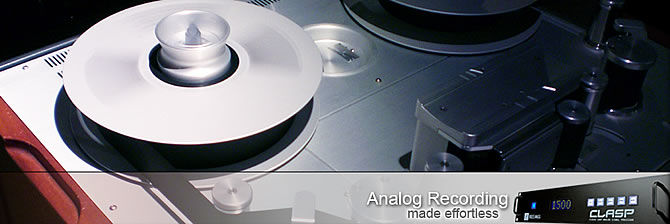As songwriter-musician Brendan Benson was brainstorming in the weeks leading up to the tracking sessions for his next solo project, his thoughts kept coming back to the sound of his favorite recordings, which were made using analog tape. Benson is by no means anti-digital, as he has embraced Pro Tools over the last several decades, based on the ease it has allowed in tracking his demos and solo projects by himself, but he strongly believes in the realistic sound of analog tape that he grew up on. Eventually he discovered the perfect way to bridge the two worlds: Endless Analog ’s CLASP™ (Closed Loop Analog Signal Processor), which uniquely integrates analog tape machines into the digital audio production workflow.
“When I first heard about the CLASP, I was intrigued, and I said, ‘Sure, let’s give it a shot,’ but I’ll admit I was leery,” recalls Benson. “But then Chris Estes [Endless Analog President/Founder and CLASP inventor] was generous enough to show my engineer Joe Costa and me how it worked and let us hang onto it for a few days. I must say, I was very impressed. It does exactly what it is supposed to, and its stability is rock-solid – it just doesn’t screw up. Joe had a crash course in CLASP, and he was just as impressed as I was. We ended up buying the unit and have been using it ever since. And CLASP is just so cool – there’s no latency. It’s just genius. I’m surprised no one thought of this sooner! Chris Estes made it happen.”
Costa, who has also worked with Ben Folds and The Greenhornes, was happy to welcome CLASP into his workflow for the Benson project. “CLASP is a great, very innovative piece of hardware and software,” he notes. “Since you are recording to analog and capturing it immediately, there’s no concern with high-end loss, from the tape passing over the heads time and time again during overdubs. You get the analog tape benefits, but you still have all the computer benefits too. Everything lined up perfectly like it was supposed to. Having no latency was impressive. Using this system is like instant gratification. We would be recording an overdub using the computer, and when we played it back, there was the analog sound we were enjoying during tracking! Chris Estes really created something revolutionary here.”
“The sound using CLASP and analog tape is definitely noticeably better, compared to strictly-digital,” notes Benson. “I’m always going for that warmer analog sound. I understand why the digital tools are important, but there are so many analog sounds that are musical and pleasing in a way that digital is not. Drums and cymbals are a great example – when you hit a cymbal, it kind of flaps around and it sort of sprays the sound, which is hard to pick up digitally. But on tape there’s this glue and natural compression that makes all the difference in the world.”
In terms of signal flow, Costa and Benson were willing to mix it up and experiment. In fact, they have the distinction of being the first people to ever use CLASP with a quarter-inch mono head stack machine. Recalls Costa, “We actually used three different tape machines so far. The first sessions, before we had CLASP set up, were done with an MCI JH24 2-inch 24-track tape machine. I transferred those tracks into Pro Tools, and then, when we were setting up CLASP with Chris Estes for more tracking and overdubs, we had an MCI JH110 quarter-inch mono tape machine, along with Brendan’s MCI JH110 one-inch eight-track machine. Chris set up CLASP for both, and then we just kept going back and forth. Depending on what we were doing for an overdub, that would determine our tape machine. We ended up using the mono quarter-inch for anything that needed some saturation (some guitars, analog synths etc.). You could just push and push the level going to it, and it sounded better and better. However, most of the overdubs went to Brendan’s one-inch eight track. It’s an extremely smooth-sounding machine. It was definitely worth having both machines set up, because they each offered a unique character. And CLASP also gives you the option of running different tape speeds within the same session, but we stayed at 15 ips. It is great to have that flexibility and an additional palette of colors to choose from.”
Benson‘s upcoming album will be hitting stores in late 2011 or early 2012.
Visit www.endlessanalog.com and www.brendanbenson.com for more information.


